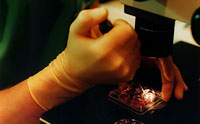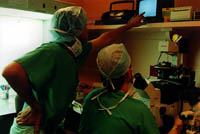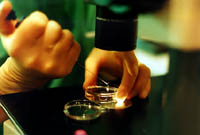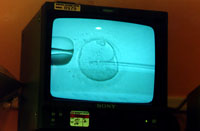3. PREPARING SPERM
 |
|
Embryologist Brent Anderson looks for live sperm in a semen sample. The
patient has a very low sperm count; the doctor had to punch a small hole in
his testicle to remove sperm. Anderson is having trouble finding enough
live sperm to use to fertilize eggs.
|
|
 |
|
Anderson moves the semen sample to a machine that shows it magnified on
a screen. He and Dr. Manish Mehta, a urologist (pointing), look for live
sperm. They find enough to go ahead with fertilization using a procedure
called intracytoplasmic sperm injection, or ICSI, in which sperm is
injected directly into eggs.
|
|
 |
|
Anderson draws sperm into a needle in preparation for ICSI.
|
|
 |
|
A magnified egg ready for ICSI. A pipette gently holds the egg in place
with suction (left). The line on the right is the needle which will
penetrate the egg and deposit a single sperm cell inside.
|
|
End of visit.
The Fertility Industry home
|